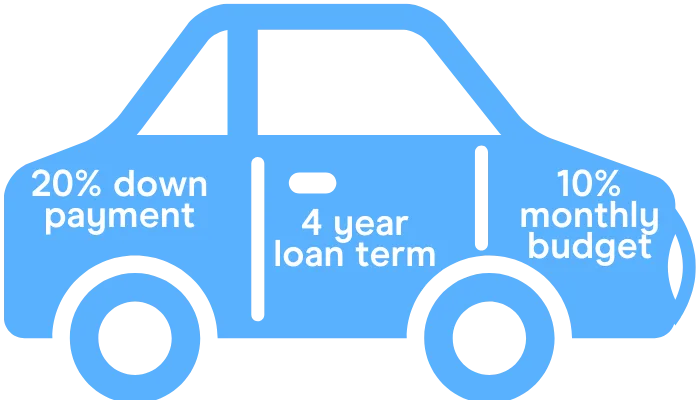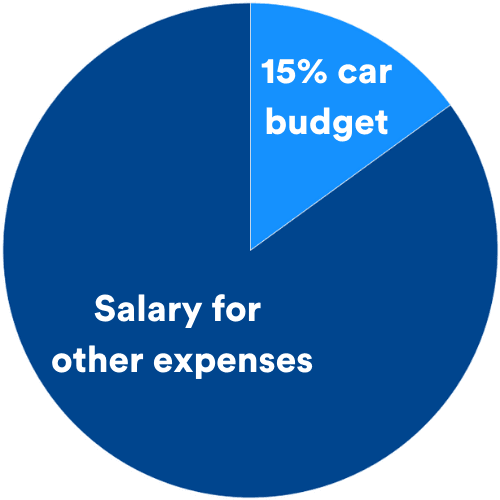Total cost of the car × 0.2 = $down payment
You want to buy a car but might be asking yourself if you can afford it. Answering that question now can help ensure you don’t end up stretching your budget too thin with car payments you can’t comfortably manage.
Before taking out any kind of car loan, find out what your personal borrowing power is so that you know how much you’re eligible for and can steer clear of financing you can’t afford.
Key takeaways
- Try to stick to the 20/4/10 rule, which is a 20% down payment, four-year loan term or less and car payments that are under 10% of your pre-tax income.
- Be sure to take into account gas prices of the make and model you’re interested in.
- Consider your debt-to-income ratio, which shouldn’t be more than 40%.
How much car can I afford?
One of the best ways to decide how much car you can afford is to use strategies like the 20/4/10 rule and the 10% to 15% rule. These strategies factor in important (and expensive) costs beyond the loan payment, like insurance, gas and maintenance, so that your car budget is both realistic and affordable.
Finder survey: Are men or women more likely to rate monthly repayments as an important factor when applying for a car loan?
| Response | Female | Male |
|---|---|---|
| Monthly payment | 61.74% | 54.25% |
What is the 20/4/10 rule?
The 20/4/10 rule suggests that you make a 20% down payment, get a loan term 4 years long or less and keep monthly car payments (including principal, interest and all operating costs) at or below 10% of your monthly pre-tax income.
The 20/4/10 rule is meant to be a guideline to help you calculate how much car you can afford—it’s not a strict rule. If you can only afford to put 15% down or need to extend your car loan term to 5 or 6 years, that’s okay.
20% down payment
The 20/4/10 rule suggests that you use a down payment of around 20% when buying a car to offset depreciation that kicks in as soon as you drive off the lot. For example, for a car costing $20,000, you would need a $4,000 down payment.
Start saving your down payment as soon as possible. Making a down payment will reduce the risk of incurring negative equity, which is when you owe more against the car than what it’s worth.
4-year loan term or less
Although car loan terms can range from two to seven years, the 20/4/10 rule states that you should aim for a four-year term or less. That’s because you’ll pay more interest on longer loan terms. You can compare car loan terms and interest rates in the table below. Longer loan terms can also have a negative impact on your car insurance costs.
What are the current car loan rates?
10% of your monthly income on all car expenses
The last component of the 20/4/10 rule is to keep all costs of car ownership to 10% or less of your pre-tax monthly income. If you spend too much on your car, you may struggle to meet your other financial commitments.
Remember that operating costs include more than just the car loan payment. Consider gas, insurance, maintenance, licence and registration, parking and so on.
Total monthly income × 0.1 = $monthly car budget
The 10% to 15% rule for how much to spend based on salary
The 10% to 15% rule gives you a general guideline for estimating how much car you can afford based on your salary. The rule states that the total operating cost of a car should fall between 10% and 15% of your annual income. Check out the this table to determine how much car you can afford based on your salary.

| Annual salary | 10%–15% car budget | Monthly budget |
|---|---|---|
| $30k | $3,000–$4,500 | $250–$375 |
| $50k | $5,000–$7,500 | $417–$625 |
| $80k | $8,000–$12,000 | $667–$1,000 |
| $100k | $10,000–$15,000 | $833–$1,250 |
This rule helps you budget for a car based on your salary, while ensuring you still have income available for other living costs, savings, emergency funds and so on after covering your vehicle expenses.
Remember that the 10-15% rule is merely a guideline. If you spend closer to 20% of your salary, that’s okay too. Everyone’s budget is unique, which means some can afford to spend more on a car.
What car can I afford with my salary?
Using the 10%–15% rule to understand how much car you can afford based on your salary is a good way to help narrow down your vehicle options. To give you an idea of the car you may be able to afford with your salary, here are some potential options.
Keep in mind that the 10%–15% rule is designed to take into account all operating costs, including insurance and gas, which will vary a lot based on the type of car, where you live and how often you drive. So, assuming a 20% down payment, these example vehicles may not fit all budgets but can instead be used simply as a starting point for your search.
What car can I afford with a $40k salary?
Following 10%–15% rule, we can estimate the maximum purchase price that someone earning a $40,000 annual salary can afford to spend on a car is $10,000. While it’s unlikely you’ll find an affordable new car with a $40,000 annual salary, there are many used cars that could fall within your budget.
Used vehicles:
- 2016 Dodge Caravan
- 2016 Kia Sorento
- 2016 Hyundai Elantra
- 2014 Ram 1500
- 2014 Ford Edge
- 2012 RAV4
- 2012 Jeep Grand Cherokee
What car can I afford with a $70k salary?
Based on the 10%–15% rule, cars you can afford on a $70,000 salary will typically have to fall under a MSRP of around $36,000. Vehicles that fall within this range of affordability include the following.
New vehicles:
- 2024 Honda Civic
- 2023 Ford Mustang
- 2024 Hyundai Elantra
- 2024 Mazda Mazda3
- 2023 Chevrolet Bolt EV
- 2024 Hyundai Kona
Used vehicles:
- 2020 Mercedes-Benz C-Class
- 2014 Mercedes-Benz E-Class
- 2018 Ford F-150
- 2017 BMW X5
- 2022 Honda CR-V
What car can I afford with a $100k salary?
If you’re making an annual salary of $100,000, we can estimate based on the 10%–15% rule that you can spend up to $65,000 (MSRP) on a car. This is only a maximum approximation, so it’s best to carefully examine your personal financial obligations before deciding what works for your budget.
Some of the cars you can afford on that salary include the following vehicles.
New vehicles:
- 2024 Toyota Rav4
- 2024 Toyota Tacoma
- 2024 Audi A4 Sedan
- 2024 Ford Mustang
- 2024 BMW 3 Series
- 2024 Tesla Model 3
- 2024 Tesla Model Y
Used vehicles:
- 2023 Ford F-150
- 2022 BMW X5
- 2023 Acura MDX
- 2023 Jeep Gladiator Rubicon
- 2020 Cadillac CT5
Car loan affordability calculator
Decide how much car you can afford by calculating how much your car loan monthly payments will cost.|
Your loan
|
|---|
| Loan amount |
|
$
|
| Loan terms (in years) |
|
|
| Interest rate |
|
%
|
Fill out the form and click on “Calculate” to see your estimated monthly payment.
or
Compare car loans nowBased on your loan terms
| Principal | $ |
|---|---|
| Interest | $ |
| Total Cost | $ |
Gas prices for popular makes and models in Canada
With the cost of gas on the rise, it’s important to make sure you factor in realistic gas prices when making your budget to decide how much car you can afford. To help you out, we’ve compiled a list of example gas prices in Canada for popular used car models, assuming you’re filling up an entire empty tank of gas.
| Model | Fuel tank capacity (L) | Gas prices (based on $1.40/L) | Gas prices (based on $1.80/L) |
|---|---|---|---|
| 2024 Toyota RAV4 | 57 | $79.80 | $102.60 |
| 2024 Honda CR-V | 53 | $74.20 | $95.40 |
| 2024 Honda Civic | 46.9 | $65.66 | $84.42 |
| 2024 Toyota Corolla | 47 | $65.80 | $84.60 |
| 2024 Hyundai Kona | 47 | $65.80 | $84.60 |
| 2024 Nissan Rogue | 55 | $77.00 | $99.00 |
| 2021 Ford F-150 | 98 | $137.20 | $176.40 |
| 2023 Chevrolet Silverado 1500 | 107 | $149.80 | $192.60 |
| 2023 Ram 1500 | 87 | $121.80 | $156.60 |
| 2021 GMC Sierra | 107 | $149.80 | $192.60 |
 What are the most fuel efficient cars in 2024?
What are the most fuel efficient cars in 2024?
If you’re on the market for a new vehicle, knowing how much gas a vehicle uses per km can help narrow down your options based on fuel efficiency and potentially save big in the long run. Here is a list of the most fuel efficient vehicles in 2024, according to Natural Resources Canada.
- Mazda MX-5
- MINI Cooper Convertible
- MINI Cooper 3 Door
- MINI Cooper 5 Door
- Toyota Corolla Hybrid
- Hyundai Elantra Hybrid
- Hyundai Sonata Hybrid
- Kia Soul
- Volvo V90 CC B6 AWD
- Ford Maverick Hybrid
- Chevrolet Silverado
- GMC Sierra
- Kia Niro FE
- Toyota Highlander Hybrid AWD
- Toyota Highlander Hybrid AWD Limited/Platinum
- Toyota Sienna
Calculate how much car you can afford in 3 steps
There are three main steps to determine how much to spend on a car.
Step 1: Determine how much to spend on a car based on income and savings
In general, there are three main costs associated with buying a car: the down payment, the car loan payment (including principal and interest) and the ongoing operating costs.
It’s easy to find a car loan with no down payment, but most lenders prefer between 10% and 20% upfront when you apply for car financing. Having a large down payment lowers the amount you need to borrow to pay for the car, making it easier to qualify for a loan.
Look into your savings to figure out how much funds you have available to put down without disrupting your monthly spending habits. Don’t have any savings? You might want to hold off on the car loan until you do.
There are a couple of ways to go about determining how much you should spend on a car:
- Review your budget and determine how much you can reasonably afford to spend on a car monthly. Also consider your savings and how much you’re willing to spend upfront on a down payment.
- Use the 20/4/10 rule: 20% on a down payment, a loan term no longer than four years and 10% of your pre-tax income on car loan payments and operating costs.
- Use the 10% to 15% rule: 10%–15% of your pre-tax annual income is a benchmark for car loan payments and operating expenses.
Step 2: Shop around for cars
At this point, you should have a figure in mind for the down payment and monthly operating costs, including car payments and other car ownership expenses. Now you can begin shopping around for cars that are within your budget. Make sure to research the car price, insurance, gas, repairs, maintenance and other costs of ownership. Fortunately, most of this information can be found through a simple Google search. Check out our guide on the best used car sites in Canada to start your search, which includes:
Step 3: Put your budget to the test
Once you have a few cars in mind, it’s time to put your budget to the test. Do the cars you want actually work with your budget? After your down payment, are the monthly car payment and operating costs still within the amount you allocated? To answer these questions, check out the car affordability calculator for Canada here.
If you find that the cars you want don’t fit within your budget, you have a few options. Either explore cheaper cars or revisit your budget. If you still can’t find a way to fit a car into your budget, it may not be the right time for you to make a car purchase.
How do lenders determine my borrowing power?
Borrowing power is the amount of money you can borrow at a specific point in time, based on your financial position. Lenders may use the criteria below to determine the final amount you’re able to borrow:
- Your credit score. This is usually the most critical component influencing how much you may be able to borrow. Lenders use your credit score and credit history to predict a borrower’s potential risk.
- Annual income. Lenders consider your income when determining your ability to repay a loan. If a lender doesn’t feel that your income will allow you to repay a large loan properly, it may only approve you for a small amount.
- Multiple incomes. The more income you have, the more borrowing power you have.
- Living expenses. Lenders want to be sure that your new car payment will fit into your budget along with housing costs, utility bills, credit card bills, student loans and other monthly bills.
- Your savings. How much you have in your savings account could be used as a buffer in the event that you’re unable to repay a car loan with your normal income. If you have more cash savings, a lender may approve you for a larger amount.
- People who are financially dependent on you. Having dependents can add to your monthly expenses, which can impact your borrowing power.
Debt-to-income ratio and borrowing power
Another important factor rolled into how much you can borrow is your debt-to-income ratio. A good rule of thumb is that the debt you pay each month should account for no more than 40% of your gross monthly income; anything much higher may be seen as a red flag.
Note: If your calculation includes only minimum payments on your credit card(s), your debt-to-income ratio is actually higher than you figured. This is because minimum payments don’t show that you’re eliminating debt, just that you’re maintaining it. When looking at your finances, lenders are specifically looking to see how good you are at getting rid of debt. After all, they want you to pay back your car loan, not struggle to make your payments.
How can I increase my borrowing power?
There are a few different ways to convince lenders that you’re capable of taking on a bigger loan, however, it may take some time and effort. A few strategies you can use to get a bigger loan in the future are:
- Spend less. Drawing up a budget and sticking with it can free up some cash flow and help you create less debt. Once your start spending less, you can take those savings and knock down whatever debt you’ve accumulated in the past.
- Improve your credit score. Paying bills on time, decreasing your debt-to-income ratio, using your credit card responsibly and correcting mistakes on your credit report can nudge your score in the right direction.
- Eliminate debt. Cutting your debt minimizes your credit utilization ratio, showing lenders that you’re not desperate for a line of credit.
- Ask for a pay raise. Doing a great job at work and think you deserve a raise? Make a case as to why you deserve a pay increase. This extra bump will decrease your debt-to-income ratio and make you a more attractive borrower.
- Compare. Every lender may look at your ability to borrow differently. This is why it’s extremely important to get a few quotes and do your research before moving forward with a loan offer.
- Get a cosigner. A cosigner promises to take care of the loan if you default, increasing your borrowing power. Only ask someone to be a cosigner if you’re sure you’ll have no problem making payments on your loan.
Find a car loan that’s right for you
Finder Score for car loans
To make comparing even easier, we came up with the Finder Score. Interest rates, fees and features across 20+ car loans are all weighted and scaled to produce a score out of 10. The higher the score the better the loan—simple.
How do I avoid overspending on a car loan?
1. Compare rates before visiting the dealership
One of the most common pieces of advice is to get preapproved for a car loan with two or three lenders before you visit a dealership. Not only will this allow you to see what types of rates you can expect, but you’ll also have another tool in your arsenal when it comes time to negotiate. Dealerships are notorious for marking up interest rates to earn a larger profit, so comparing rates will help you get the best deal.
2. Opt for a shorter loan term
The longer your loan term, the more you’ll pay in interest. While opting for a lengthy term will lower your monthly repayments, it can cause you to go upside down on your car loan. This means you owe the lender more than your car is actually worth.
Although there are 72- and 84-month terms available, try to go for a term no longer than 60 months or ideally no longer than 48 months, according to the 20/4/10 rule. If you’re buying a used car, try to keep your term even shorter. A 36- or 48-month term can save you thousands of dollars over the life of your loan.
3. Focus on the overall price of the car
With 84-month terms available on new cars, keep a strict rule about how much you’re willing to pay overall for the vehicle. Salespeople may tack on extras you don’t need to inflate the price of the car to meet the amount you’re willing to pay monthly. While your monthly payment amount is important, be sure to keep an eye on your total cost too.
4. Be on the lookout for fees
Make sure you understand any fees you might be charged on top of interest. Often, you’ll be charged an origination fee (often included in the APR) when you first take out a loan. Ask if you’ll face a prepayment penalty for making extra repayments or for paying off your car loan early.
Lenders may also charge a late fee, although there might be a short grace period. In addition to regular fees for borrowing, you’ll also be responsible for sales tax, registration costs and licensing fees. These vary depending on your province/territory, the car you buy and the dealership you choose.
When working with both the lender and dealership, ask for a breakdown of fees. You could negotiate these if you found a more competitive offer elsewhere. Check out our guide on the true cost of buying a car to learn more.
5. Review your terms before signing
You’re bound to any loan contract you sign. Before committing to anything, read through the contact carefully, making note of the interest rate, loan term, fees and monthly payment. Be on the lookout for any language that might be signs of a scam, like extra fees you don’t remember discussing. If your lender or salesperson can’t explain anything that doesn’t look right, you may want to hold off on your purchase until you can find a more reputable provider.
Bottom line
Remember to take into account all fees and taxes including the cost of the vehicle when determining how much car you can afford. Using strategies like the 20/4/10 rule or the 10%–15% rule can help you calculate exactly how much you can afford based on your salary. Now that you know what to expect from lenders and what kind of borrowing power you have, you’re ready to compare car loans.
Frequently asked questions about car affordability
Sources
More guides on Finder
-
Best used cars to buy in Canada
Shopping for a used car to buy in Canada? Check out these 12 options to suit any budget.
-
10 best cars under $30k in Canada
Buying on a budget? These are the best new cars for $30k or less in Canada.
-
Best cars to buy in Canada
Whether you want a small car, a family sedan or a luxury SUV, these are the best cars to buy in Canada.
-
How much is the average car payment in Canada?
Looking to buy a new car? Find out how much Canadians will typically spend on car payments.
-
Best car-buying apps in Canada
Your guide to the best apps and sites to help you buy a car in Canada.
-
7 steps for importing a car into Canada
Looking to import a car into Canada? Find out what steps you’ll need to take and what barriers you might face.
-
Best cars under $25k in Canada
No matter what you’re looking for in a vehicle, these are the best budget cars in Canada.
-
Fees and charges when buying a new or used car in Canada
Find about the fees and charges you need to pay on top of the MSRP when buying a car.
-
How to buy and finance a Tesla in Canada
Most cars are an investment, but none so much as a Tesla. If you’re looking at purchasing one, this guide will show you how to find the best model for you and how to make your purchase.


 Molly earns $85,000 per year (or $7,083 per month) before taxes, and she’s interested in buying a car. According to the 20/4/10 rule, she calculates that 10% of her monthly salary is $708 per month. She then estimates how much she’ll have to spend per month on
Molly earns $85,000 per year (or $7,083 per month) before taxes, and she’s interested in buying a car. According to the 20/4/10 rule, she calculates that 10% of her monthly salary is $708 per month. She then estimates how much she’ll have to spend per month on 